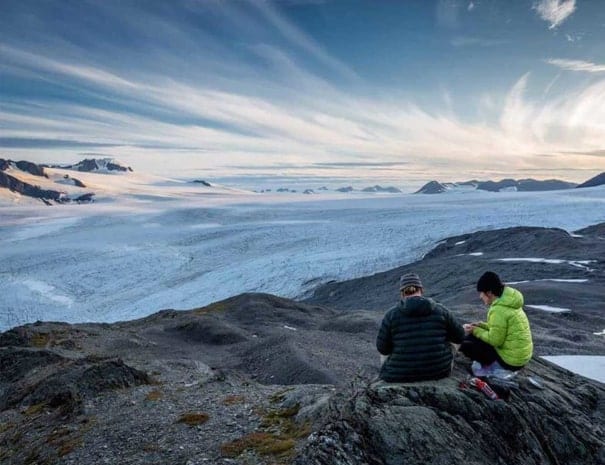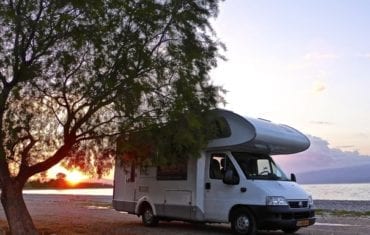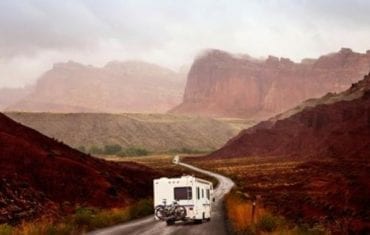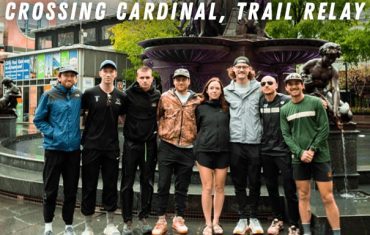It just made financial sense.” If that sounds like a far-out explanation for why Joe Neiheisel and Emilie Johnson decided to quit their jobs, sell their house, and travel the U.S. in a decked-out Mercedes Sprinter, well, maybe it is. But they earned this.
The journey to get to the point where it was realistic—practical, even—for the two to travel full-time has been a much longer one than the trek they’re on now. Joe and Emilie, now in their mid-40s, worked corporate gigs for more than 20 years. They climbed their way up to executive positions, while spending weekends camping, hiking, biking, and daydreaming about trying something new.
Eight years in the making, that “something new” turned from dream to reality on Christmas Day 2016, when they finally hit the road for good.
Now, Emilie and Joe are more than 3,000 miles from where they began, having just launched a two-month, 7,000-mile trip through British Columbia and Alaska. And that’s where I caught up with the pair for this interview: In rainy White Horse, capital of the Yukon Territories.


Emilie and Joe’s van in Moab, Utah at sunset. | Photo: @permanentroadtrip
Hannah: Tell me about how the idea to live on the road permanently came up. Who proposed it and what was the conversation about it like?
Emilie: We had been saving for a number of years with the goal of doing something kind of adventurous. We didn’t know if that meant just trying a new town for a while or what. But we knew we loved to get out west. We love to camp, we love to be outdoors.
This whole idea of vanlife was definitely Joe’s idea. I wasn’t too hard to sell on it, I guess. We never really could settle on one place where we could see ourselves giving it another try. We really did have it good in Cincinnati in so many ways.
Joe: We always did fun, outdoorsy vacations. We didn’t go to the beaches and stuff—we were always going somewhere to ride or ski or whatever.
I saw this van in Victor, Idaho—it was a sports mobile—back in 2012. I was like, “That would be perfect. You could live in that thing.” Then, over the years, we looked at a bunch of them. And we thought about buying one for a long time.
Emilie: With Joe’s background being in finance, he can look at everything from a very practical, pragmatic standpoint, and it—buying the van and building it out—was just hard to justify the expense when we were totally fine tent-camping on the weekends. But then we realized that if we sold our house and quit our jobs, we could do this thing full-time.
At some point, we had all the toys that we needed or wanted and we just started really cutting back on our expenses. We’d been working our jobs, each of us, for 20-plus years and never had kids. So that always gives you a little bit of flexibility there and kind of ease of saving, too.

Emilie and Joe’s pup, Uschi, resting up after an operation. | @permanentroadtrip

Exploring Ruby Horsethief Canyon, Loma, Colorado. | @permanentroadtrip
Where is next?
Emilie: From Alaska, we have more of Washington that we want to explore and we have definitely more of Oregon that we want to explore. Then we will head back into California. There are some other states—Arizona, New Mexico—that we haven’t done a ton in. Nor have we done a ton in Montana and Wyoming. We are talking about maybe spending some of early next year down in Baja. So we might do that.


Emilie and Joe’s van park near a rainbow. | Photo: @permanentroadtrip
Do you usually have a pretty regimented schedule? Or do you normally play it by ear?
Emilie: We play almost everything by ear. This one we’ve planned just because of the sheer drive and the size of Alaska. It’s a huge, huge investment of time and miles on the van.
Tell me about buying and selecting the van.
Joe: I looked for a van for a while. It was kind of hard to find what I was looking for. But one day it came up. It was a two-year-old cargo van with two slider doors, which was incredibly rare. It had 25,000 miles on it. I went out to South Bend, Indiana the day after I saw it listed and brought it back. It had been five years of thinking about this and trying to figure out everything we needed. You know, we camped so much we knew exactly what we needed for this kind of lifestyle.
We got a bunch of help from a bunch of different people. I was basically the general contractor. I got all the supplies, got them to the right place at the right time, and coordinated between the guys who helped us with the carpentry, and solar, etc. I just tried to make sure everything happened before we got out of there that year.


Emilie and Joe sitting on a rock above a glacier. | Photo: @the_mountain_m
So what was the timeline from when you bought the van to when you hit the road?
Joe: We started working in earnest in September. So basically September, October, November, and December. We had almost four whole months to work on it.
And total cost?
Emilie: Joe could tell you to the penny. I think with the van, the cost of the van included, and then the cost of material, labor, were at right around $91,000.
Joe: Yeah, that’s everything for $91,000. That includes, like, the sheets, the water kettle, and the French press and everything in here.
We spent a lot more than you have to, because we were committed to doing this for several years. We had to spend the $1,000 on the furnace. We had to spend $300 extra to get the altitude compensator for the furnace. We got a really nice refrigerator because Emilie likes to cook.
You could get a decent van that’s travel-worthy for 15 to 20 grand and enjoy it for a couple years. But I wanted to be in this permanent, full-time for four years, five years maybe. Then I wanted to have it for another five to 10 years afterward. So, I wanted to put the money in, make it perfect, get it just right, and meet all of the needs that we had, which are much more broad than most people who go out and live in a van.


Setting up a mountainside camp for the night. | Photo: @permanentroadtrip


Making dinner in the desert. | Photo: @permanentroadtrip


Exploring the Subway at Zion National Park. | Photo: @permanentroadtrip
Why’d you pick the vehicle that you did?
Joe: The engine on this thing is a 500,000-mile diesel engine. That was the reason why we went with the Mercedes Sprinter. That diesel engine is just phenomenal. We’re getting about 26 miles per gallon. That’s considerably better fuel efficiency than most people, and as much as we drive, we need it.
What was it like adjusting to spending 24/7 together?
Emilie: Before we hit the road, we thought we spent a ton of time together. We grocery shopped together, we walked the dog together, we exercised together, we would drive to work together, we’d have lunch together.
For the average couple, we spent a lot of time together. But this takes it to a whole new level. I don’t know if anybody has it totally figured out, but we do pretty well for sure.
It’s also really apparent when one of us needs some space, so we are getting much better as time goes on about just figuring that out. The thing is—it’s tricky—if one person leaves with the van, then the other person has to kind of figure out, “What is it I want to do? What do I need?”
Often we are in areas that don’t have any kind of cell service. Then, you have to commit to a meet up time. So, there are logistics, but nothing too major to conquer. It’s nothing to take lightly, either.
FOR THE AVERAGE COUPLE, WE SPENT A LOT OF TIME TOGETHER. BUT THIS TAKES IT TO A WHOLE NEW LEVEL.
So any words of wisdom to a couple just starting out on the road?
Emilie: People just kind of need to figure it out and understand that, while it may seem like an easy life, it’s not an easy life. Basic things that you do in a day just take longer when you are in a van. Just be patient and kind to each other and respect when someone may need a little time to themselves.
If you could go back and tell yourselves something before you hit the road, what would it be?
Joe: Don’t go to Canada in February. (laughs)
Emilie: Yeah, don’t go to Canada in February. Negative 35 degrees Fahrenheit. It’s a little brutal, brutal all around.


What a view to wake up to. The Vermillion Lakes, Canada. | Photo: @permanentroadtrip
There’s a perception out there that people who are able to live the vanlife are privileged in some way. What do you think about that?
Joe: Well, it’s kind of silly because it doesn’t cost anything to live in a van.
I track what we spend. I always have. Last year, our first full year in the van, we spent just about $25,000 on everything.
Someone who works the starting salary at the Moab McDonald’s is making that. So even if we didn’t have a penny, we could go work at the Moab McDonald’s for six months and spend the other six months of the year traveling. That’s how inexpensive it is.


Making dinner in the Anasazi Valley, Utah. | Photo: @permanentroadtrip
So do you guys wish you had done this while you were back in your 20s?
Emilie: I mean, we could say that we wish we had. But Joe had student loans to pay off. We both kind of jumped right in and started working full-time, pursuing careers. So I don’t think this was even a thought.
Joe: Yeah, I’m totally glad that we waited. When I look at younger people doing it, they’re definitely having fun. But it’s a considerably different experience for them.
Even with people who’ve found a way to make money on the road, if you’re working from a coffee shop or hustling to find WiFi, that’s totally different than what we are doing.
We don’t have to worry about being somewhere for a conference call or getting online to do some work. We are just out doing what we love and it’s natural. We don’t have to mix business with pleasure. We did all of our business, we saved the money, now we can live off the investment and really enjoy this experience.
Emilie: We’ll figure it out when the time comes.
At some point we will return to doing some kind of work. What I think this road trip has done—for me, anyway—is just to open my eyes. What we were so used to, being from the Midwest, is everything being 9-to-5 Monday through Friday. This has definitely opened my eyes to the fact that’s not everybody. There are many other non-traditional ways to jump back in.
Joe: Playing cards on Wednesday and hanging with my buddies.
Emilie: Some people will say what they missed most is a sense of community. Really, I think, for us, our definition of community has changed. We have between six and 10 friends, couples, that we have met along the road that we continue to meet up with. Whenever our paths are about to cross, we figure out a way to join up again.
The thing that took us so long to leave in Cincinnati is that we had a big community there. We had really good friends who had similar recreational interests, friends that we were camping with all the time, biking with all the time, our family is there. So our sense of community has just sort of been redefined.
Written by Hannah McCartney, for RoadTrippers.








